The Nizams were the 18th-through-20th-century rulers of Hyderabad. Nizam of Hyderabad (Niẓām ul-Mulk, also known as Asaf Jah) was the title of the monarch of the Hyderabad State (as of 2019 divided between the state of Telangana, Hyderabad-Karnataka region of Karnataka and the Marathwada region of Maharashtra). Nizam, shortened from Nizam-ul-Mulk, meaning Administrator of the Realm, was the title inherited by Asaf Jah I. He was the viceroy of the Great Mughal in the Deccan, the premier courtier in Mughal India in 1724, and the founding “Nizam of Hyderabad”.
The Asaf Jahi dynasty was founded by Mir Qamar-ud-Din Siddiqi (Asaf Jah I), who served as a viceroy of the Deccan under the Mughal Empire from 1713 to 1721. He intermittently governed the region after Emperor Aurangzeb’s death in 1707. In 1724 Mughal control weakened, and Asaf Jah became virtually independent of the Mughal Empire; Hyderabad would then become a tributary of the Maratha Empire, losing a series of battles through the 18th century.
When the East India Company achieved paramountcy over the Indian subcontinent, they allowed the Nizams to continue to rule their princely states as client kings. The Nizams retained internal power over Hyderabad State until 17 September 1948, when Hyderabad was integrated into the new Indian Union. The Asaf Jah dynasty had only seven rulers; however there was a period of 13 unstable years after the rule of the first Nizam when three of his sons (Nasir Jung, Muzafar Jung and Salabath Jung) ruled. They were never officially recognised as rulers. The seventh and last Nizam, Mir Osman Ali Khan, fell from power when India annexed Hyderabad in 1948 which is known as operation polo or police action
Hyderabad
By the time of its annexation, Hyderabad was the largest and most prosperous one among all the princely states. It covered 82,698 square miles (214,190 km2) of fairly homogeneous territory and had a population of roughly 16.34 million people (as per the 1941 census), of which a majority (85%) was Hindu. Hyderabad State had its own army, airline, telecommunication system, railway network, postal system, currency and radio broadcasting service. Hindus were also given highest of the government posts; like 2-time Prime Minister of Hyderabad – Maharaja Sir Kishen Pershad, Maharaja Chandu Lal and Raja Sham Raj I. Raja Sham Raj II, a member of H. E. H Nizam’s Executive Council. The position of Kotwal was also given to a Hindu, Raja Bahadur Venkatarama Reddy.
History
Etymology
The name Nizam comes from Urdu نظام /nɪˈzɑːm/, which itself is derived from Arabic language niẓām which means “order” or “arrangement”. Nizām-ul-mulk was a title first used in Urdu around 1600 to mean Administrator of the Realm. The word is derived from the Arabic language, as in Abu Ali Hasan ibn Ali Tusi (11 April 1018 – 14 October 1092), better known by his honorific title of Nizam al-Mulk (Arabic: نظام الملک, “Order of the Realm”).
Descent
According to Sir Roper Lethbridge in The Golden Book of India (1893), the Nizams are lineally descended from the First Caliph Abu Bakr, the successor of the Prophet Muhammed. The family of Nizams in India is descended from Abid Khan, a Turkoman from Samarkand, whose lineage is traced to Sufi Shihab-ud-Din Suhrawardi (1154–91) of Central Asia. In the early 1650s, on his way to hajj, Abid Khan stopped in Deccan, where the young prince Aurangzeb, then Governor of Deccan, cultivated him. Abid Khan returned to the service of Aurangzeb to fight in the succession wars of 1657–58. After Aurangzeb’s enthronement, Abid Khan was richly rewarded and became Aurangzeb’s favourite nobleman. His son Ghazi Uddin Khan received in marriage, Safiya Khanum, the daughter of the former imperial prime minister Sa‘dullah Khan. Mir Qamaruddin Khan, the founder of the line of Nizams, was born of the couple, thus descending from two prominent families of the Mughal court.
Ghazi Uddin Khan rose to become a General of the Emperor Aurangzeb and played a vital role in conquering Bijapur and Golconda Sultanates of Southern India in 1686. He also played a key role in thwarting the rebellion by Prince Akbar and alleged rebellion by Prince Mu`azzam.

Map of India in 1760. The southern area in green was ruled by the Nizam.
After Aurangzeb’s death and during the war of succession, Qamaruddin and his father remained neutral thus escaping the risk of being on the losing side; they remained marginal players in the Mughal court during the reigns of Bahadur Shah I (1707–12) and Jahandar Shah(1712–13). Their successor Farrukhsiyar (1713–19) appointed Qamaruddin the governor of Deccan in 1713, awarding him the title Nizam-ul-Mulk. However, the governorship was taken away two years later and Qamaruddin withdrew to his estate in Moradabad. Under the next emperor, Muhammad Shah (1719–48), Qamaruddin accepted the governorship of Deccan for the second time in 1721. The next year, following the death of his uncle Muhammad Amin Khan who had been a power-broker in the Mughal Court, Qamaruddin returned to the Delhi and was made the wazir (prime minister). According to historian Faruqui, his tenure as prime minister was undermined by his opponents and a rebellion in Deccan was engineered against him. In 1724, the Nizam returned to Deccan to reclaim his base, in the process making a transition to a semi-independent ruler.
Reign
In 1724, Asaf Jah I defeated Mubariz Khan to establish autonomy over the Deccan Suba, named the region Hyderabad Deccan, and started what came to be known as the Asaf Jahi dynasty. Subsequent rulers retained the title Nizam ul-Mulk and were referred to as Asaf Jahi Nizams, or Nizams of Hyderabad. Nizam I never formally declared independence from the Mughals; he still flew the Mughal flag, and was never crowned. In Friday prayers, the sermon would be conducted in the name of Aurangzeb, and this tradition would continue until the end of Hyderabad State in 1948. The death of Asaf Jah I in 1748 resulted in a period of political unrest as his sons, backed by opportunistic neighbouring states and colonial foreign forces, contended for the throne. The accession of Asif Jah II, who reigned from 1762 to 1803, ended the instability. In 1768 he signed the treaty of Machilipatnam, surrendering the coastal region to the East India Company in return for a fixed annual rent.

Hyderabad State in 1909
Following the decline of the Mughal power, the region of Deccan saw the rise of the Maratha Empire. The titullar Nizams themselves fought during the Mughal-Maratha Wars since the 1720s, which resulted in the Nizam paying a regular tax (Chauth) to the Marathas. The major battles fought between the Marathas and the Nizam include Palkhed, Bhopal, Rakshasbhuvan, and Kharda, in all of which the Nizam lost. Following the conquest of Deccan by Bajirao I and the imposition of chauth by him, the Nizam remained a tributary of the Marathas for all intent and purposes.

The sixth Nizam riding an elephant in a procession from Moula Ali, circa. 1890s.
In 1805, after the East India Company victory in the Second Anglo-Maratha War, the Nizam of Hyderabad came under their protection.
In 1903 the Berar region of the state was separated and merged into the Central Provinces of British India, to form the Central Provinces and Berar.
The last Nizam of Hyderabad state, Mir Osman Ali Khan crowned in 1911, had been the richest man in the world in his time. The Nizams developed the railway, introduced electricity, and developed roads, airways, irrigation and reservoirs; in fact, all major public buildings in Hyderabad City were built during his reign during the period of British rule in India. He pushed education, science, and establishment of Osmania University.
In 1947, at the time of the partition of India, the British government offered the 565 princely states in the sub-continent the options of acceding to either India or Pakistan, or remaining independent.
End of the dynasty

General Syed Ahmed El Edroos (at right) offers his surrender of the Hyderabad State Forces to Major General (later General and Army Chief) Jayanto Nath Chaudhuri at Secunderabad.
After the Independence of India in 1947, the Nizam of Hyderabad chose to join neither India nor Pakistan. He later declared Hyderabad an independent state as the third dominion, but the Government of India refused to accept this. After attempts by India to persuade the Nizam to accede to India failed, and due to large scale atrocities committed by Razakars (who wanted the Nizam to accede Hyderabad to Pakistan) on the Hindu populace, the Indian government finally launched a military operation named Operation Polo. When the Indian Army invaded Hyderabad on 13 September 1948 and defeated his untrained forces. The Nizam capitulated on 17 September 1948; that same afternoon he broadcast the news over the State radio network. The Nizam was forced to accept accession to the new Republic of India. His abdication on 17 September 1948 was the end of the dynasty’s ambitions. Still he became the Rajpramukh, post independence based on public vote.
Mir Osman Ali Khan, the last Nizam, died on Friday 24 February 1967. All the Nizams are buried in royal graves at the Makkah Masjid near Charminar in Hyderabad excepting the last, Mir Osman Ali Khan, who wished to be buried beside his mother, in the graveyard of Judi Mosque facing King Kothi Palace.
State wealth
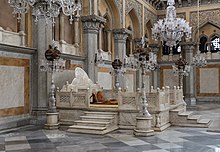
The Nizam’s of Hyderabad throne in Chowmahalla Palace
During the period of the Nizams’ rule, Hyderabad became wealthy – thanks to the Golconda mines which were the ‘only sources of diamonds in the world market at that time (apart from South African mines) making the 7th Nizam the richest person in the world. Osman Ali Khan, Asaf Jah VII and his family including Salar Jung I were taught by Nawab Sarwar Ul Mulk and Agha Mirza Baig Bahadur, who was his political advisor, and the senior-most salute state among the Indian princely states. It was spread over 223,000 km2 (86,000 sq mi) in the Deccan, ruled by the Asaf Jahi dynasty. The Nizams were conferred with the title of His Exalted Highness, and “Faithful Ally of the British Government” for their roles in the Secondand Third Anglo-Mysore Wars and the Indian Rebellion of 1857, becoming the only Indian prince to be given both these titles.
One example of the wealth of the Nizams are the Jewels of the Nizams, an international tourist attraction once displayed in Salar Jung Museum, but now locked in an Reserve Bank of India vault in Delhi. In 1948 Hyderabad state had an estimated population of 17 million (1.7 crore), and it generated an estimated annual revenue of £90,029,000.
The state had its own currency known as the Hyderabadi rupee, until 1951. The pace at which the last Nizam Mir Osman Ali Khanamassed wealth made him one of the world’s richest men in 1937, also known for his miserliness. He was estimated to be worth ₹ 660 crores (roughly US$2 billion by the then exchange rates). According to the Forbes All-Time Wealthiest List of 2008, Nizam Mir Osman Ali Khan is the fifth richest man in recorded history per the figures, with an estimated worth of US$210.8 billion adjusted by Forbes as per the growth of the US GDP since that period and the present exchange rate of the US dollar against the Indian rupee.
Institutions
The Nizams set up numerous institutions in the name of the dynasty including hospitals, schools, colleges, and universities that imparted education in Urdu. Inspired by the Indian Civil Service, the Nizams established their own local Hyderabad Civil Service.
Infrastructure
The Nizams commissioned engineering projects such as large reservoirs like Osman Sagar and Himayat Sagar. Survey work on the Nagarjuna Sagar Dam was also initiated during this time, although the actual work was actually completed under the aegis of the Government of India in 1969.
They also gave Hyderabad its own Railway Network -the Nizam’s Guaranteed State Railway which helped in setting up various industries.
Other landmarks include the Telangana High Court, City College, Public Gardens, (formerly Bagh-e-Aaam) Jubilee Hall, Asafia Library, The Assembly building, Niloufer Hospital, the Osmania Arts College and the Osmania Medical College.
Donation for compilation of Mahabharata
In 1932, there was a need for money for the publication of Mahabharata in the Bhandarkar Oriental Research Institute located in Pune. A formal request was made to the 7th Nizam – (Mir Osman Ali Khan) who granted Rs. 1000 per year for a period of 11 years.
He also gave Rs 50,000 for construction of the guest house which stands today as “Nizams guest house”
Donation to Hindu Temples
The Nizams donated Rs. 82,825 to the Yadagirigutta temple at Bhongir, Rs. 29,999 to Sita Ramachandraswamy temple, Bhadrachalam
The 7th Nizam also donated Rs. 8,000 to Tirupati Balaji Temple as yearly grants.
A donation of Rs. 50,000 towards the re-construction of Sitarambagh temple located in the old city of Hyderabad was also made.
Palaces
The Asaf Jahis were prolific builders. Their palaces are listed below:
- Chowmahalla Palace – Official residence of early Nizams
- Purani Haveli
- King Kothi Palace
- Mahboob Mansion
- Falaknuma Palace
- Bella Vista
- Hill Fort Palace
- Chiran Palace
- Saifabad Palace
- Hyderabad House, New Delhi
- Nizam Palace, Kolkata
List of Nizams of Hyderabad (1724–1948)
| Image | Titular Name | Personal Name | Date of birth | Nizam From | Nizam Until | Date of death |
|---|---|---|---|---|---|---|
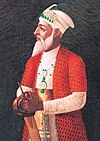 |
Nizam-ul-Mulk, Asaf Jah I نظامالملک آصف جاہ |
Mir Qamar-ud-din Khan | 20 August 1671 | 31 July 1724 | 1 June 1748 | |
 |
Nasir Jung نصیرجنگ |
Mir Ahmed Ali Khan | 26 February 1712 | 1 June 1748 | 16 December 1750 | |
 |
Muzaffar Jung مظفرجنگ |
Mir Hidayat Muhi-ud-din Sa’adullah Khan | ? | 16 December 1750 | 13 February 1751 | |
 |
Salabat Jung صلابت جنگ |
Mir Sa’id Muhammad Khan | 24 November 1718 | 13 February 1751 | 8 July 1762 (deposed) |
16 September 1763 |
 |
Nizam-ul-Mulk, Asaf Jah II نظامالملک آصف جاہ دوم |
Mir Nizam Ali Khan | 7 March 1734 | 8 July 1762 | 6 August 1803 | |
 |
Sikander Jah, Asaf Jah III سکندر جاہ ،آصف جاہ تریہم |
Mir Akbar Ali Khan | 11 November 1768 | 6 August 1803 | 21 May 1829 | |
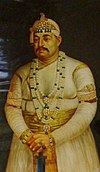 |
Nasir-ud-Daula, Asaf Jah IV ناصر الدولہ ،آصف جاہ چارہم |
Mir Farqunda Ali Khan | 25 April 1794 | 21 May 1829 | 16 May 1857 | |
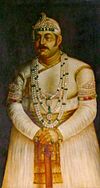 |
Afzal-ud-Daula, Asaf Jah V افضال الدولہ ،آصف جاہ پنجم |
Mir Tahniyath Ali Khan | 11 October 1827 | 16 May 1857 | 26 February 1869 | |
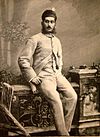 |
Asaf Jah VI آصف جاہ شیشم |
Mir Mahbub Ali Khan | 17 August 1866 | 26 February 1869 | 29 August 1911 | |
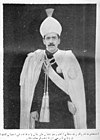 |
Asaf Jah VII آصف جاہ ہفتم |
Mir Osman Ali Khan | 6 April 1886 | 29 August 1911 | 17 September 1948 (deposed) |
24 February 1967 |
Descendants of the last Nizam
The Nizam was reported to have fathered many children; as few as 34, and as many as 149 or more, including more than 100 illegitimate children.
The Asaf Jahi dynasty followed the Order of Precedence of male primogeniture regardless of the mother’s marital status or rank.
His eldest son was Azam Jah (21 February 1907 – 9 October 1970),was the Prince of Berar.
Whereas, his second son Moazzam Jah, married Princess Niloufer, a princess of the Ottoman empire.
Family tree
 I. Asaf Jah I, Yamin us-Sultanat, Rukn us-Sultanat, Jumlat ul-Mulk, Madar ul-Maham, Nizam ul-Mulk, Nizam ud-Daula, Khan-i-Dauran, Nawab Mir Ghazi ud-din Siddiqi, Khan Bahadur, Fath Jang, Sipah Salar, Nawab Subedar of the Deccan, 1st Nizam of Hyderabad (cr. 1720) (20 August 1671 – 1 June 1748). A senior governor and counsellor in the Imperial government. Defeated the Imperial forces on 19 June 1720 at Hasanpur and formed an independent state of his own. Confirmed in his possessions by Imperial firmanand crowned on 31 July. Named Vice-Regent of the Mughal Empire by Emperor Muhammad Shah on 8 February 1722, secured the province of Berar on 11 October 1724 and formally made Hyderabad City his new capital on 7 December 1724.
I. Asaf Jah I, Yamin us-Sultanat, Rukn us-Sultanat, Jumlat ul-Mulk, Madar ul-Maham, Nizam ul-Mulk, Nizam ud-Daula, Khan-i-Dauran, Nawab Mir Ghazi ud-din Siddiqi, Khan Bahadur, Fath Jang, Sipah Salar, Nawab Subedar of the Deccan, 1st Nizam of Hyderabad (cr. 1720) (20 August 1671 – 1 June 1748). A senior governor and counsellor in the Imperial government. Defeated the Imperial forces on 19 June 1720 at Hasanpur and formed an independent state of his own. Confirmed in his possessions by Imperial firmanand crowned on 31 July. Named Vice-Regent of the Mughal Empire by Emperor Muhammad Shah on 8 February 1722, secured the province of Berar on 11 October 1724 and formally made Hyderabad City his new capital on 7 December 1724.
 II. Humayun Jah, Nizam ud-Daula, Nawab Mir Ahmad ‘Ali Siddiqi, Khan Bahadur, Nasir Jang, Nawab Subedar of the Deccan, 2nd Nizam of Hyderabad (26 February 1712 – k. by the Nawab of Kadapa 16 December 1750; r. 1 June 1748 – 16 December 1750).
II. Humayun Jah, Nizam ud-Daula, Nawab Mir Ahmad ‘Ali Siddiqi, Khan Bahadur, Nasir Jang, Nawab Subedar of the Deccan, 2nd Nizam of Hyderabad (26 February 1712 – k. by the Nawab of Kadapa 16 December 1750; r. 1 June 1748 – 16 December 1750).- Sahibzadi Khair un-nisa Begum. Married Nawab Talib Muhi ud-din Mutasawwil Khan Bahadur, Muzaffar Jang:
 III. Nawab Hidayat Muhi ud-din Sa’adu’llah Siddiqi, Khan Bahadur, Muzaffar Jang, Nawab Subedar of the Deccan, 3rd Nizam of Hyderabad (k. by the Nawab of Kurnool 13 February 1751; r. 16 December 1750 – 13 February 1751).
III. Nawab Hidayat Muhi ud-din Sa’adu’llah Siddiqi, Khan Bahadur, Muzaffar Jang, Nawab Subedar of the Deccan, 3rd Nizam of Hyderabad (k. by the Nawab of Kurnool 13 February 1751; r. 16 December 1750 – 13 February 1751).
 IV. Amir ul-Mamalik, Asaf ud-Daula, Nawab Said Muhammad Siddiqi, Khan Bahadur, Zaffar Jang, Nawab Subadar of the Deccan, 4th Nizam of Hyderabad (November 1718 – 16 September 1763; r. 13 February 1751 – 8 July 1762). Deposed by his younger brother on 8 July 1762 and killed in prison the following year, aged 44.
IV. Amir ul-Mamalik, Asaf ud-Daula, Nawab Said Muhammad Siddiqi, Khan Bahadur, Zaffar Jang, Nawab Subadar of the Deccan, 4th Nizam of Hyderabad (November 1718 – 16 September 1763; r. 13 February 1751 – 8 July 1762). Deposed by his younger brother on 8 July 1762 and killed in prison the following year, aged 44. V. Asaf Jah II, Nizam ul-Mulk, Nizam ud-Daula, Nawab Mir Nizam ‘Ali Siddiqi, Khan Bahadur, Fath Jang, Sipah Salar, Nawab Subadar of the Deccan, 5th Nizam of Hyderabad (7 March 1734 – 6 August 1803; r. 8 July 1762 – 6 August 1803)
V. Asaf Jah II, Nizam ul-Mulk, Nizam ud-Daula, Nawab Mir Nizam ‘Ali Siddiqi, Khan Bahadur, Fath Jang, Sipah Salar, Nawab Subadar of the Deccan, 5th Nizam of Hyderabad (7 March 1734 – 6 August 1803; r. 8 July 1762 – 6 August 1803)
 VI. Asaf Jah III, Muzaffar ul-Mamaluk, Nizam ul-Mulk, Nizam ud-Daula, Nawab Mir Akbar ‘Ali Siddiqi, Khan Bahadur, Fulad Jang, 6th Nizam of Hyderabad (11 November 1768 – 21 May 1829; r. 6 August 1803 – 21 May 1829). The first of the dynasty to be officially granted the title of Nizam.
VI. Asaf Jah III, Muzaffar ul-Mamaluk, Nizam ul-Mulk, Nizam ud-Daula, Nawab Mir Akbar ‘Ali Siddiqi, Khan Bahadur, Fulad Jang, 6th Nizam of Hyderabad (11 November 1768 – 21 May 1829; r. 6 August 1803 – 21 May 1829). The first of the dynasty to be officially granted the title of Nizam.
 VII. Rustam-i-Dauran, Aristu-i-Zaman, Asaf Jah IV, Muzaffar ul-Mamaluk, Nizam ul-Mulk, Nizam ud-Daula, Nawab Mir Farkhanda ‘Ali Siddiqi, Khan Bahadur , Sipah Salar, Fath Jang, Ayn waffadar Fidvi-i-Senliena, Iqtidar-i-Kishwarsitan Muhammad Akbar Shah Padshah-i-Ghazi, 7th Nizam of Hyderabad(25 April 1794 – 16 May 1857; r. 21 May 1829 – 16 May 1857).
VII. Rustam-i-Dauran, Aristu-i-Zaman, Asaf Jah IV, Muzaffar ul-Mamaluk, Nizam ul-Mulk, Nizam ud-Daula, Nawab Mir Farkhanda ‘Ali Siddiqi, Khan Bahadur , Sipah Salar, Fath Jang, Ayn waffadar Fidvi-i-Senliena, Iqtidar-i-Kishwarsitan Muhammad Akbar Shah Padshah-i-Ghazi, 7th Nizam of Hyderabad(25 April 1794 – 16 May 1857; r. 21 May 1829 – 16 May 1857).
 VIII. Asaf Jah V, Nizam ul-Mulk, Afzal ud-Daula, Nawab Mir Tahniyat ‘Ali Siddiqi, Khan Bahadur, 8th Nizam of Hyderabad, GCSI (11 October 1827 – 26 February 1869; r. 16 May 1857 – 26 February 1869). The first of the dynasty to come under British rule.
VIII. Asaf Jah V, Nizam ul-Mulk, Afzal ud-Daula, Nawab Mir Tahniyat ‘Ali Siddiqi, Khan Bahadur, 8th Nizam of Hyderabad, GCSI (11 October 1827 – 26 February 1869; r. 16 May 1857 – 26 February 1869). The first of the dynasty to come under British rule.
 IX. Rustam-i-Dauran, Arustu-i-Zaman, Wal Mamaluk, Asaf Jah VI, Muzaffar ul-Mamaluk, Nizam ul-Mulk, Nizam ud-Daula, Nawab Mir Mahbub ‘Ali Siddiqi, Khan Bahadur, Sipah Salar, Fath Jang, 9th Nizam of Hyderabad GCB, GCSI (17 August 1866 – 31 August 1911; r. 26 February 1869 – 31 August 1911). Succeeded his father on 26 February 1869, ruled under a regency until 5 February 1884, when he was invested with full ruling powers by the Viceroy of India.
IX. Rustam-i-Dauran, Arustu-i-Zaman, Wal Mamaluk, Asaf Jah VI, Muzaffar ul-Mamaluk, Nizam ul-Mulk, Nizam ud-Daula, Nawab Mir Mahbub ‘Ali Siddiqi, Khan Bahadur, Sipah Salar, Fath Jang, 9th Nizam of Hyderabad GCB, GCSI (17 August 1866 – 31 August 1911; r. 26 February 1869 – 31 August 1911). Succeeded his father on 26 February 1869, ruled under a regency until 5 February 1884, when he was invested with full ruling powers by the Viceroy of India.
 X. Rustam-i-Dauran, Arustu-i-Zaman, Wal Mamaluk, Asaf Jah VII, Muzaffar ul-Mamaluk, Nizam ul-Mulk, Nizam ud-Daula, Nawab Mir Osman ‘Ali Siddiqi, Khan Bahadur, Sipah Salar, Fath Jang, Faithful Ally of the British Government, 10th Nizam of Hyderabad and of Berar GCSI, GBE, Royal Victorian Chain, MP (6 April 1886 – 24 January 1967; r. 31 August 1911 – 26 January 1950). Granted the style of His Exalted Highness (1 January 1918), the title of Faithful Ally of the British Government (24 January 1918) and Nizam of Hyderabad and of Berar (13 November 1936). The last of the ruling Nizams; ruled absolutely from his accession until 19 September 1948, when the state was formally annexed to the Union. Maintained semi-ruling and semi-autonomous status from then until 23 November 1949, when he accepted the paramountcy of the new Indian government and Constitution and acceded to the Union. Formally lost his sovereignty, ending 230 years of Asaf Jahi rule, upon the formal promulgation of the Constitution on 26 January 1950. Served as Rajpramukh of the new Hyderabad State from 26 January 1950 until 31 October 1956, when the post was abolished. Served as a titular monarch from 26 January 1950 until his death.
X. Rustam-i-Dauran, Arustu-i-Zaman, Wal Mamaluk, Asaf Jah VII, Muzaffar ul-Mamaluk, Nizam ul-Mulk, Nizam ud-Daula, Nawab Mir Osman ‘Ali Siddiqi, Khan Bahadur, Sipah Salar, Fath Jang, Faithful Ally of the British Government, 10th Nizam of Hyderabad and of Berar GCSI, GBE, Royal Victorian Chain, MP (6 April 1886 – 24 January 1967; r. 31 August 1911 – 26 January 1950). Granted the style of His Exalted Highness (1 January 1918), the title of Faithful Ally of the British Government (24 January 1918) and Nizam of Hyderabad and of Berar (13 November 1936). The last of the ruling Nizams; ruled absolutely from his accession until 19 September 1948, when the state was formally annexed to the Union. Maintained semi-ruling and semi-autonomous status from then until 23 November 1949, when he accepted the paramountcy of the new Indian government and Constitution and acceded to the Union. Formally lost his sovereignty, ending 230 years of Asaf Jahi rule, upon the formal promulgation of the Constitution on 26 January 1950. Served as Rajpramukh of the new Hyderabad State from 26 January 1950 until 31 October 1956, when the post was abolished. Served as a titular monarch from 26 January 1950 until his death.
- Azam Jah, Prince of Berar GCIE, GBE (21 February 1907 – 9 October 1970). Granted the title of His Highness the Prince of Berar (13 November 1936). Passed over in the line of succession in 1967 in favour of his elder son.
 XI. Rustam-i-Dauran, Arustu-i-Zaman, Wal Mamaluk, Asaf Jah VIII, Muzaffar ul-Mamaluk, Nizam ul-Mulk, Nizam ud-Daula, Nawab Mir Barakat ‘Ali Siddiqi, Khan Bahadur, Sipah Salar, Fath Jang, 11th Nizam of Hyderabad and Berar (b. 6 October 1933; 11th Nizam: 24 January 1967 – 28 December 1971; dynastic head and pretender since then).
XI. Rustam-i-Dauran, Arustu-i-Zaman, Wal Mamaluk, Asaf Jah VIII, Muzaffar ul-Mamaluk, Nizam ul-Mulk, Nizam ud-Daula, Nawab Mir Barakat ‘Ali Siddiqi, Khan Bahadur, Sipah Salar, Fath Jang, 11th Nizam of Hyderabad and Berar (b. 6 October 1933; 11th Nizam: 24 January 1967 – 28 December 1971; dynastic head and pretender since then).
- Azmat Jah, Nawab Mir Muhammad Azmat ‘Ali Siddiqi, Khan Bahadur (b. 23 June 1960; appointed Prince of Berar and heir apparent: 2002)
- Azam Jah, Prince of Berar GCIE, GBE (21 February 1907 – 9 October 1970). Granted the title of His Highness the Prince of Berar (13 November 1936). Passed over in the line of succession in 1967 in favour of his elder son.
The Nizams’ daughters had been married traditionally to young men of the Paigah family. This family belonged to the Sunni sect.
italics – Considered pretenders by most historians; refrained from exercising traditional authority during their reigns.
Places, things named after and established by the Nizams
Places and things named after the Nizam include Nizamabad, a city and district in the state of Telangana; Jamia Nizamia, a university; the Nizam College; the Nizam’s Museum; the Nizam’s Guaranteed State Railway; the Nizam’s Institute of Medical Sciences; the Jewels of the Nizams; the Nizam Diamond; the Nizam Sagar, HMAS Nizam, Nizamia observatory; the Nizam Club; the Nizam of Hyderabad necklace; the Nizam’s Contingent; the Nizam Gate; the Nizam Palace; Government Nizamia General Hospital; and H.E.H. the Nizam’s Charitable Trust.
